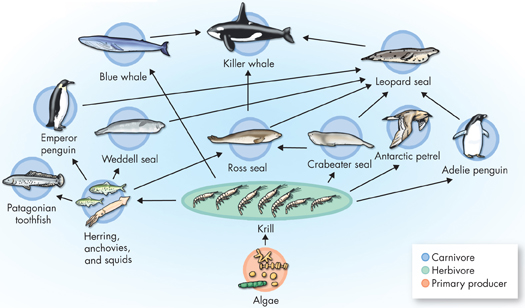Food Webs and Disturbance Food webs are complex, so it is often difficult to predict exactly how they will respond to environmental change. Look again at Figure 3–9, and think about the questions an ecologist might ask about the feeding relationships in it following a disturbance. What if an oil spill, for example, caused a serious decline in the number of the bacteria and fungi that break down detritus? What effect do you think that might have on populations of crayfish? How about the effects on the grass shrimp and the worms? Do you think those populations would decline? If they did decline, how might pig frogs change their feeding behavior? How might the change in frog behavior then affect the other species on which the frog feeds?
Relationships in food webs are not simple, and, as you know, the food web in Figure 3–9 has been simplified! So, you might expect that answers to these questions would not be simple either, and you'd be right. However, disturbances do happen, and their effects can be dramatic. Consider, for example, one of the most important food webs in the southern oceans. All of the animals in this food web, shown in Figure 3–10, depend directly or indirectly on shrimplike animals called krill, which feed on marine algae. Krill are one example of a diverse group of small, swimming animals, called zooplankton (zoh oh PLANK tun), that feed on marine algae. Adult krill browse on algae offshore, while their larvae feed on algae that live beneath floating sea ice. In recent years, krill populations have dropped substantially. Over that same period, a large amount of sea ice around Antarctica has melted. With less sea ice remaining, there are fewer of the algae that grow beneath the ice. Given the structure of this food web, a drop in the krill population can cause drops in the populations of all other members of the food web shown.
MYSTERY CLUE
Researchers discovered that zooplankton in Narragansett Bay now graze on floating algae more actively through the winter than they ever did before. What effect do you think this might have on the annual late-winter “bloom” of algae that occurs in the water?


Figure 3–10 Antarctic Food Web All of the animals in this food web depend on one organism: krill. Disturbances to the krill's food source, marine algae, have the potential to cause changes in all of the populations connected to the algae through this food web.
Interpret Visuals What do ecologists mean when they say that killer whales indirectly depend on krill for survival?
dTable of Contents
- Formulas and Equations
- Applying Formulas and Equations
- Mean, Median, and Mode
- Estimation
- Using Measurements in Calculations
- Effects of Measurement Errors
- Accuracy
- Precision
- Comparing Accuracy and Precision
- Significant Figures
- Calculating With Significant Figures
- Scientific Notation
- Calculating With Scientific Notation
- Dimensional Analysis
- Applying Dimensional Analysis




